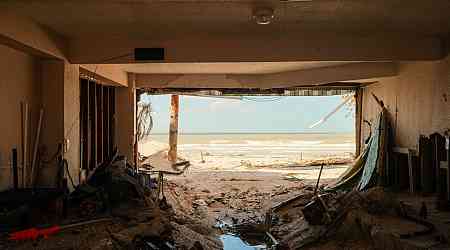
We know that the misinformation the U.S. Republican presidential candidate Donald Trump and his surrogates are spreading about Hurricanes Helene and Milton was concocted for political means. We know that taking a single Federal Emergency Management Agency (FEMA staffer) to refute bogus accusations about the agency’s practices cripples its ability to manage recovery efforts. We know that many politicians will say or do anything to get elected, even if their lies ultimately hurt their constituency.
[time-brightcove not-tgx=”true”]What you may not know is what good company these lies find themselves in when it comes to climate change.
As politicians fabricate unsubstantiated accusations about anti-Republican bias in North Carolina and bizarre assertions about how and where FEMA money is used, people in the path of Helene and Milton face a larger reckoning. These superstorms, made vastly larger by fossil fuel pollution, are not a one-off disaster. In fact, major hurricanes are predicted to grow larger and more frequent in the very near future.
Read More: See Photos of the Wreckage from Hurricane Milton in Florida
The math could not be more simple. And yet, Americans suffer from collective amnesia, unable to believe that the geophysical fallout from the climate crisis is, well, real. But here’s what the science tells us: More Category 4 and 5 hurricanes hit the U.S. mainland in the last seven years than the 50 before. Since the 1970s, the likelihood of a hurricane developing into a Category 3 storm or higher increased by about 8% per decade. The number of major hurricanes, including a new breed of “ultra-intense” Category 5 storms with winds of at least 190 miles per hour, is expected to increase by 20% by 2100.
The reason: 90% of the heat humans have created is absorbed by the ocean, and ocean heat beneath a hurricane acts like gasoline on a fire—sparking a convective explosion, stronger winds, larger storm surge, more precipitation, and more tornados. If a hurricane passes over a marine heat wave—that are increasingly sweeping through the oceans—storm growth is immediate, as seen in both Helene and Milton.
In the next decade, tropical cyclones will last longer, and some will move slower, multiplying the damage. A possible westward migration of the North Atlantic tropical cyclone generation zone will likely result in an uptick of landfalls along the U.S. East Coast later this century. A 2022 study by Yale University researchers showed that warmer waters in the north and south will soon draw extreme storms poleward, threatening to inundate densely populated cities like Washington D.C., New York, Boston, Beijing, and Tokyo. A recent study by Brooklyn’s First Street Foundation also shows how hurricanes will penetrate farther inland in decades to come, affecting US states as far west as New Mexico, Kansas, and Wisconsin.
At risk on the U.S. mainland are 60 million coastal residents from Texas to Maine, a dozen major seaside cities, thousands of coastal towns, half the nation’s oil-refining business, and major infrastructure like highways, airports, trains, and much of the shipping industry—already backed up with supply-chain issues as it transports 90% of all foreign trade. This comes at a cost. Estimates for Hurricane Helene alone have already crested $250 billion. Milton’s damages is expected to cost insurers $60 billion.
And hurricanes are not the only threat. Excess heat in the atmosphere and oceans is amplifying all weather. Just look at 2023 that saw more billion-dollar weather disasters in the United States than ever before, as record heat, rainfall, and a historic 1,197 tornadoes tore across the country and a parade of atmospheric rivers—made wetter and more intense by climate change—dumped more than 30 trillion gallons of water on the state of California, on the heels of a years-long megadrought and some of the worst wildfires in the state’s history. As it turns out, adding an estimated .07 watts of heat to every square meter of land and water on the planet is influencing much of what’s in the ocean and sky, even the poofy thunderheads that glide over your house on a summer afternoon.
Lies about government funding, disaster relief, and weather are only the tip of the iceberg. Beneath these fabrications are a bedrock of untruths humanity has told itself about the consequences of our collective actions. You cannot drive a gasoline-powered truck to and from work every day of your adult life and expect the climate to stay the same. You can’t burn fuel oil to heat your house or use electricity from a coal-fired power plant and believe the unending march of heat waves, floods, hurricanes, tornadoes, and wildfires will end someday.
Read more: 9 Ways to Respond to Political Misinformation
Most importantly, you can’t vote climate-denying politicians into power and expect evermore powerful superstorms to subside on their own. Or for us to even survive them.
It’s important to remember that we are in charge of the climate. We already warmed the earth. We injected hurricanes with unthinkable power.
With science and solidarity, we can cool it down, as well. But first, we need to speak the truth: Hurricanes are not conspiracies. We must recognize that we are the most important factor in the climate change equation. Only then will we be able to restore climate stability, and some sanity, to our world.



























